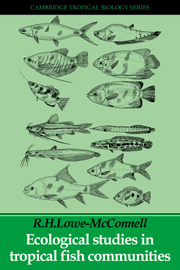Book contents
- Frontmatter
- Contents
- Preface
- Acknowledgements
- PART I INTRODUCTION
- PART II FRESHWATER STUDIES
- PART III MARINE FISH STUDIES
- PART IV SYNTHESES
- 11 Responses of fishes to conditions in tropical waters
- 12 Trophic interrelationships
- 13 Diversity: its maintenance and evolution
- 14 The exploitation and conservation of tropical fish stocks
- Appendix: Fish families in tropical waters
- References
- Index
14 - The exploitation and conservation of tropical fish stocks
Published online by Cambridge University Press: 07 May 2010
- Frontmatter
- Contents
- Preface
- Acknowledgements
- PART I INTRODUCTION
- PART II FRESHWATER STUDIES
- PART III MARINE FISH STUDIES
- PART IV SYNTHESES
- 11 Responses of fishes to conditions in tropical waters
- 12 Trophic interrelationships
- 13 Diversity: its maintenance and evolution
- 14 The exploitation and conservation of tropical fish stocks
- Appendix: Fish families in tropical waters
- References
- Index
Summary
The aim of fisheries management, to obtain the maximum (or optimum) sustained yield of fish from a water body, involves removing fishes equivalent to the amount of fish flesh produced each year (the production) without making inroads into the capital (standing stock or biomass). When comparing data from different sources, a clear distinction has to be made between biomass (stock of fish present at any one time), biological production (a rate) and the catch (yield). The yield represents only a proportion of the production and can range from almost the entire production in fishponds, to a very small proportion where fishing conditions are difficult, or where there are few fishermen, or where natural mortalities are great. As very few estimates of biological production have yet been made in natural waters (freshwater or sea), the yield (expressed as kg ha−1), is often used as an index of production, and in fisheries literature this yield or catch, i.e. the proportion of the production cropped by man, is often loosely called the ‘production’.
Comparative yields
Tropical fishes from freshwaters and the sea within easy reach of land have been fished from time immemorial by subsistence fishermen, and such fishing is still very important in many parts of the tropics. It is only in the last half century that fishing has been heavily mechanized. In the 1950s and 1960s the world catch rose very fast, more than trebling from around 20 million tonnes in 1948 to a record 71.3 million tonnes in 1979.
- Type
- Chapter
- Information
- Ecological Studies in Tropical Fish Communities , pp. 305 - 328Publisher: Cambridge University PressPrint publication year: 1987



